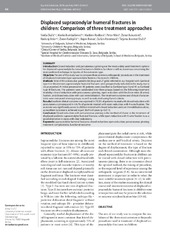Please use this identifier to cite or link to this item:
https://rfos.fon.bg.ac.rs/handle/123456789/1541| Title: | Displaced supracondylar humeral fractures in children: Comparison of three treatment approaches | Authors: | Dučić, Siniša Bumbaširević, Marko Radlović, Vladimir Nikić, Petar Bukumirić, Zoran Brdar, Radivoj Radojičić, Zoran Bukva, Bojan Abramović, Dušan Jaramaz-Ducić, Tatjana |
Keywords: | treatment complications;supracondylar humeral fractures;percutaneous pinning;open reduction;functional outcome;closed reduction | Issue Date: | 2016 | Publisher: | Srpsko lekarsko društvo, Beograd | Abstract: | Introduction Closed reduction and percutaneous pinning are the most widely used treatment options for displaced supracondylar humerus fractures in children, but there is still no consensus concerning the most preferred technique in injuries of the extension type. Objective The aim of this study was to compare three common orthopaedic procedures in the treatment of displaced extension type supracondylar humerus fractures in children. Methods Total of 93 consecutive patients (66 boys and 27 girls) referred to our hospital with Gartland type II or III extension supracondylar humeral fractures were prospectively included in the study over a six-year period. At initial presentation 48 patients were classified as Gartland type II and 45 as Gartland type III fractures. The patients were subdivided into three groups based on the following treatment modality: closed reduction with percutaneous pinning, open reduction with Kirschner wires (K-wires) fixation, and closed reduction with cast immobilisation. The treatment outcome and clinical characteristics were compared among groups, as well as evaluated using Flynn's criteria. Results Excellent clinical outcome was reported in 70.3% of patients treated with closed reduction with percutaneous pinning and in 64.7% of patients treated with open reduction with K-wire fixation. The outcome was significantly worse in children treated with closed reduction and cast immobilisation alone, as excellent outcome is achieved in just 36.4% of cases (p=0.011). Conclusion Closed reduction with percutaneous pinning is the method of choice in the treatment of displaced pediatric supracondylar humeral fracture, while open reduction with K-wire fixation is as a good alternative in cases with clear indications. | URI: | https://rfos.fon.bg.ac.rs/handle/123456789/1541 | ISSN: | 0370-8179 |
| Appears in Collections: | Radovi istraživača / Researchers’ publications |
Show full item record
This item is licensed under a Creative Commons License


